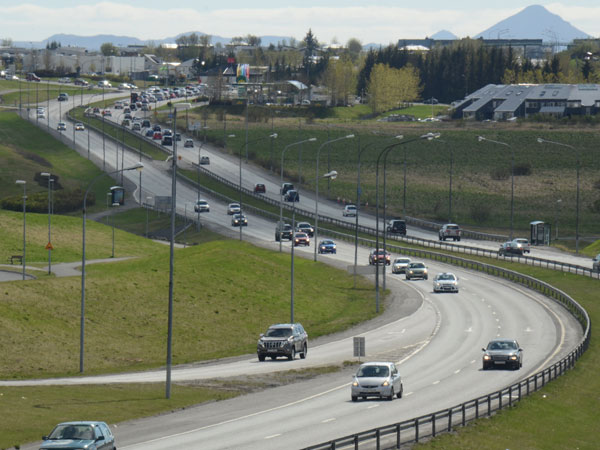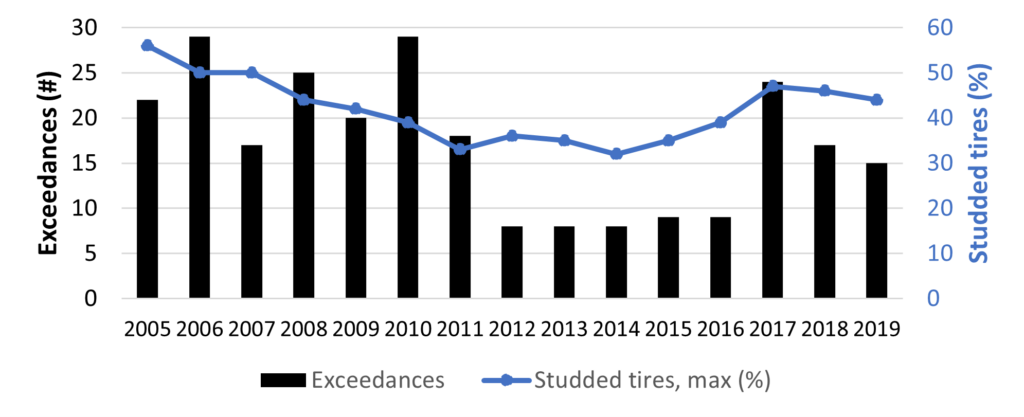Exceedances of the health limit for particulate matter (PM10) pollution, due to traffic, occur several times a year in the capital area of Iceland. Because of the adverse health effects of PM10 pollution finding ways to reduce this pollution is very important. To model possible mitigation scenarios NORTRIP is a valuable tool which was proven to successfully predict road dust episodes in the wet maritime subpolar climate of Iceland. Reducing the number of cars using studded tires is the most effective mitigation method. Reducing speed can also lead to significant reductions in PM10 produced.

Particulate matter pollution due to traffic is responsible for several exceedances of the health limit every year in the capital area of Iceland. Studded tires play a large role, but quantifying the effects and the effectiveness of various mitigating scenarios was studied using the NORTRIP model which was implemented in Iceland during the NordFoU project NORDUST.
After verifying that the NORTRIP model was able to simulate the PM10 pollution due to traffic quite well (R2=.59) for the conditions in Iceland, it was possible to use it to test mitigation strategies. Several different mitigation strategies were explored, and more will be studied in the future with simultaneous measurements in the NordFoU project NORDUST II.

Somewhat obviously, reducing the number of cars using studded tires has the biggest impact. Studded tires wear the roads 20 – 30 times faster than non-studded tires. For a baseline calculation, the average concentration of PM10 was 21 µg/m3 and there were 20 exceedances of the health limit for PM10 in the model run. Reducing the maximum number of cars using studded tires from 46% in the baseline scenario to 15% would eliminate days over the health limit according to the model and lower the average concentration by almost 50%, to 11 µg/m3. Since around the year 2000 the lowest number of cars using studded tires during winter was 32% and those were also years with very few exceedances; although weather conditions may also have an impact.
Reducing traffic speed is also an effective way to reduce road wear and therefore particulate matter pollution. In the NORTRIP model, going from 82 km/h (baseline scenario) to 66 km/h reduced the number of exceedances by 6 from the baseline scenario and the concentration by 15% (to 17 µg/m3). If only looking at the production of particulate matter reducing the velocity from 50 km/h to 30 km/h for a car using studded tires leads to ~45% reduction in PM10 material produced, and going from 70 km/h to 50 km/h by about 35%; production of particulate matter roughly corresponds to concentrations of PM10 in the atmosphere.
It is therefore clear that emphasis should be put on reducing the number of cars using studded tires. Within the greater capital area there are very few days (probably no whole days) where studded tires make a great difference regarding traffic safety. This is though complicated by the fact that outside the city the driving conditions can be very different, and many want to have the option of leaving the city. Reducing velocity during the studded tire season is another option that would reduce wear and hence the material available for suspension.
This research was supported by the Icelandic Road and Coastal Administration Research Fund.
Read more:
– Barr, Brian Charles. “Processes and Modeling of Non-Exhaust Vehicular Emissions in the Icelandic Capital Region.” Master’s Thesis, University of Iceland, 2020.
– Gjerstad, K.-I., Gustafsson, M., Blomqvist, G., Denby, B., Elmgren, M., Grythe, H., Janhäll, S., Järlskog, I., Johansson, C., Kulovuori, S., Kupiainen, K., Lundberg, J., Malinen, A., Norman, M., Ritola, R., Silvergren, S., Stojiljkovic, A., Sundvor, I., Thorsteinsson, Th., Stefani, M., Vogt, M., 2019. NORDUST- Nordic Road Dust Project.
– Throstur Thorsteinsson. “Áhrif hraða á mengun vegna umferðar” [Effect of speed on pollution due to traffic]. Report to Vegagerðin, 2021.

Contacts:
Throstur Thorsteinsson
throsturth@hi.is
University of Iceland, Iceland

Hrund Ó Andradóttir
hrund@hi.is
University of Iceand, Iceland






Follow us: